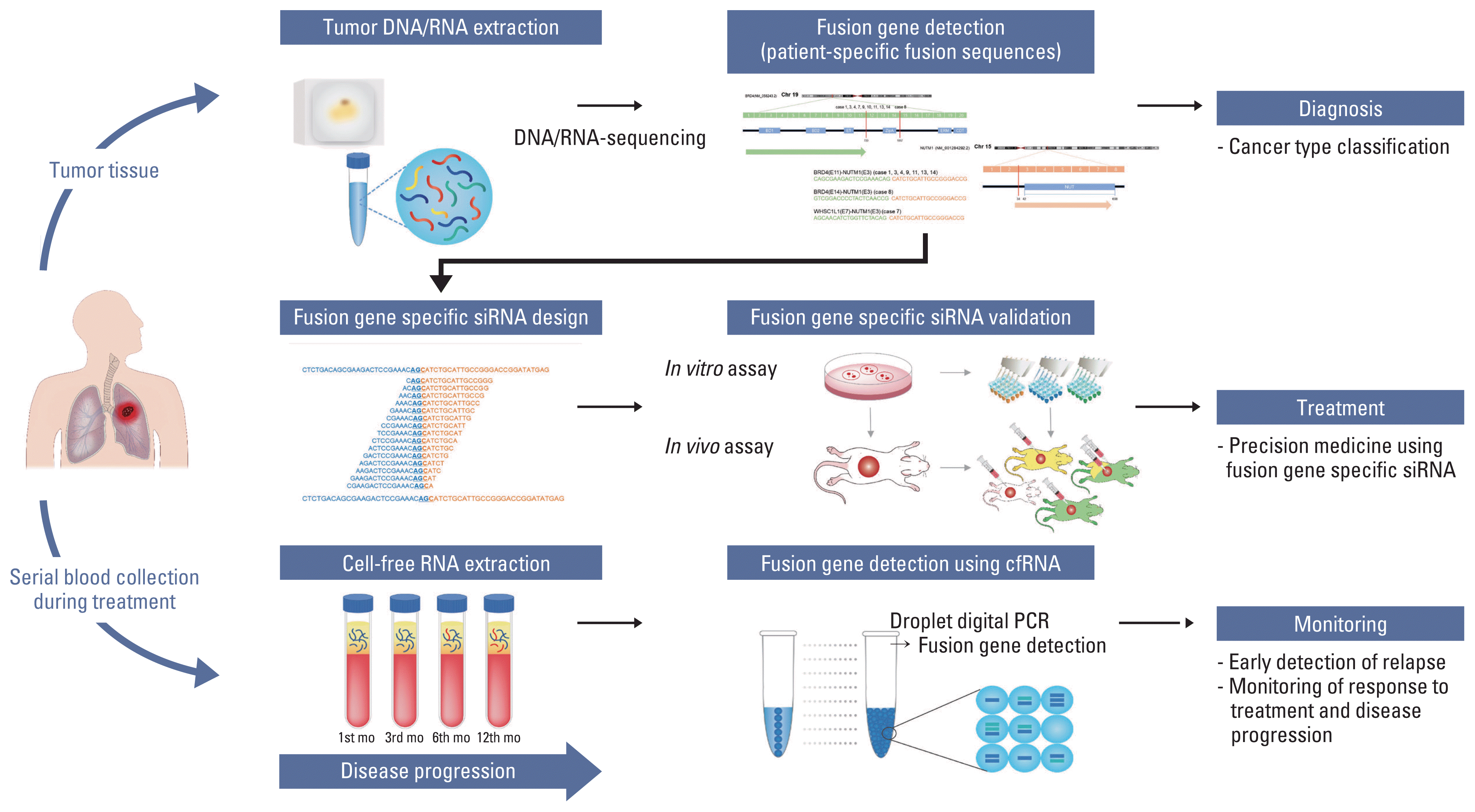Abstract
Purpose
Materials and Methods
Results
Electronic Supplementary Material
Notes
Ethical Statement
This study was reviewed and approved by the Institutional Review Board of Samsung Medical Center (approval no. 2019-05-141) and all experiments with mice conformed to the Animal Welfare guidelines and were performed in accordance with the protocols approved by the Ethics Committee.
Author Contributions
Conceived and designed the analysis: Lee MS, An S, Choi YL.
Collected the data: Sung M.
Performed the analysis: Lee MS, An S, Song JY, Jung K, Chang ES, Choi J, Oh DY.
Wrote the paper: Lee MS, An S.
Provided tumor samples: Jeon YK.
Critical comments on the manuscript: Yang H, Lakshmi C, Park S, Han J, Lee SH.
Acknowledgments
References
Fig. 1

Fig. 2

Fig. 3

Fig. 4

Fig. 5

Table 1
| Case No. | Sex | Age (yr) | Location | Sample type | Date of diagnosis | Diagnosis | IHC positive | IHC negative | Gene fusion | Detection | Last f/u date | Survival (mo) |
|---|---|---|---|---|---|---|---|---|---|---|---|---|
| 1a) | F | 42 | Pleura | Biopsy | 2019-05-20 | Metastatic squamous cell carcinoma | NUT | ALK, pan-TRK, c-MET, PD-L1 | BRD4 (E11)-NUTM1 (E3) | qRT-PCR/Archer | 2019-07-09 | Dead (2.7) |
| 2a) | M | 44 | Lung | Resection | 2019-08-12 | Poorly differentiated, non–small cell carcinoma, consistent with NUT carcinoma | NUT, MLH1, MLH2 | ALK, TTF1, CD56, p63, PD-L1 | N/D | NGS | 2021-09-09 | Alive (25.3) |
| 3a) | F | 48 | Lung | Resection | 2019-12-27 | NUT carcinoma, squamous cell type | NUT, p63 | ALK, CD56, PD-L1 | BRD4 (E11)-NUTM1 (E3) | qRT-PCR | 2020-07-23 | Alive (7.0) |
| 4a) | M | 43 | Lung | Biopsy | 2020-01-23 | Consistent with NUT carcinoma | NUT, p63 | ALK, PD-L1 | BRD4 (E11)-NUTM1 (E3) | qRT-PCR | 2021-09-17 | Alive (20.1) |
| 5a) | M | 32 | Liver | Biopsy | 2018-04-17 | Metastatic NUT carcinoma | NUT, p63 | TTF1 | NSD3 (E7)-NUTM1 (E3) | NGS | 2018-06-26 | Dead (2.7) |
| 6a) | M | 34 | Lung | Biopsy | 2018-05-10 | Atypical cell proliferation, suggestive of NUT carcinoma | NUT, TTF-1: focal, CK (AE1/AE3): focal, PD-L1 | CD45 RB, HMB45, | N/A | N/A | 2019-04-02 | Dead (12.5) |
| 7a) | M | 37 | Bronchus | Resection | 2018-07-17 | NUT carcinoma, squamous cell type with pseudoglandular pattern | NUT, p63, p16, Ki67 (15%) | ALK, CD56, PD-L1 | NSD3 (E7)-NUTM1 (E3) | Archer | 2021-07-12 | Alive (36.4) |
| 8a) | M | 49 | Pleura | Resection | 2018-11-08 | Metastatic NUT carcinoma | NUT, CD99, p53, CK (AE1/AE3): focal, p63: focal | Desmin, pan-TRK, CD34, S-100, CD56, actin (smooth muscle), PD-L1 | BRD4 (E14)-NUTM1 (E3) | Archer | 2018-12-24 | Dead (2.2) |
| 9a) | M | 45 | Lymph node | Biopsy | 2017-06-14 | Metastatic NUT carcinoma | NUT, p53, p63, CK (AE1/AE3), PD-L1, Ki67 (70%) | Chromogranin, CD99, CD45, CD56, TTF1 | BRD4 (E11)-NUTM1 (E3) | qRT-PCR | 2018-10-30 | Alive (16.8) |
| 10 | F | 19 | Lung | Resection | 2020-05-18 | NUT undifferentiated carcinoma | NUT, p53, CD56 | ALK, TTF11, PD-L1, CD34, STAT6 | BRD4 (E11)-NUTM1 (E3) | qRT-PCR | 2021-04-16 | Alive (11.1) |
| 11 | M | 43 | Nasal cavity | Biopsy | 2018-02-28 | NUT carcinoma | NUT, p53 | p16 | BRD4 (E11)-NUTM1 (E3) | qRT-PCR | 2018-03-13 | Dead (5.4) |
| 12 | M | 70 | Supraglottic and glottic malignancy | Resection | NUT carcinoma | NUT, p63, CK (AE1/AE3), Ki67 | BRD4 (E14)-NUTM1 (E3) | NGS | ||||
| 13b) | M | 45 | Lung | 2019-10-29 | NUT carcinoma | NUT, p40 | TTF1 | BRD4 (E11)-NUTM1 (E3) | ddPCR qRT-PCR | 2021-01-04 | Dead (15.6) | |
| 14 | F | 75 | Trachea | Biopsy | 2017-11-02 | NUT carcinoma | NUT, Ki67 (95%), synaptophysin: focal, CK (AE1/AE3): focal | CD30, CD56, CD45 RB | BRD4 (E11)-NUTM1 (E3) | Archer | 2018-09-23 | Dead (11.4) |
| 15 | F | 50 | Lung | Resection | 2020-07-30 | NUT carcinoma | NUT, PD-L1 | ALK | BRD4 (E11)-NUTM1 (E3) | qRT-PCR | 2021-09-06 | Alive (13.4) |
| 16 | M | 44 | Bronchus | Biopsy | 2020-08-12 | NUT carcinoma | NUT, p63 | TTF1, CD56 | BRD4 (E11)-NUTM1 (E3) | qRT-PCR | 2020-10-03 | Dead (2.8) |
| 17 | F | 72 | Lung | Resection | 2020-09-23 | Undifferentiated carcinoma, consistent with NUT carcinoma | NUT, p63, CK (AE1/AE3) | ALK, TTF1, CD56 | N/D | qRT-PCR | 2021-01-14 | Alive (3.8) |
| 18 | M | 49 | Lymph node | Biopsy | 2020-11-17 | Poorly differentiated carcinoma | NUT, p53, p63, CK (AE1/AE3), EMA, vimentin (moderate), Ki67 (15%) | ALK, PD-L1, S100 | N/D | qRT-PCR | 2021-09-23 | Alive (10.3) |
ALK, anaplastic lymphoma kinase; CK, cytokeratin; ddPCR, droplet digital polymerase chain reaction; EMA, epithelial membrane antigen; f/u, follow-up; HMB45, human melaoma black 45; IHC, immunohistochemistry; N/A, not available; N/D, not detected; NGS, next-generation sequencing; PD-L1, programmed death-ligand 1; qRT-PCR, quantitative reverse transcription polymerase chain reaction; TTF1, thyroid transcription factor 1.
a) Previously reported cases by Dr. Joungho Han [26],




 PDF
PDF Citation
Citation Print
Print



 XML Download
XML Download